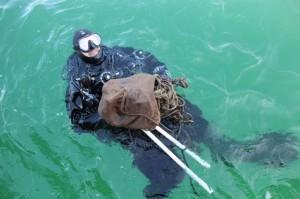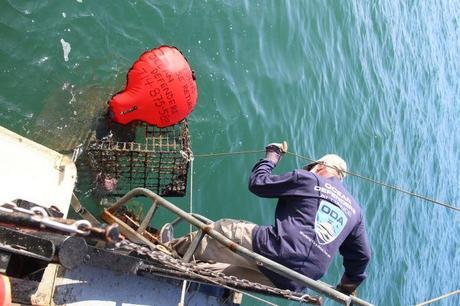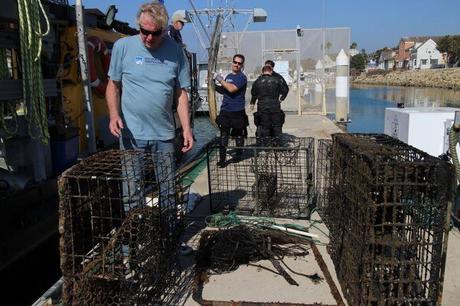by Jed Kim / Southern California Public Radio

Whenever Kurt Lieber takes his 40-foot boat Clearwater out onto the ocean, he always hopes for a big catch.
But when you’re angling for derelict fishing gear, a big catch is a mixed blessing. On the one hand, it means he and the divers of the Ocean Defenders Alliance have cleaned the ocean floor of lost equipment that is harming the marine ecosystem. On the other hand, it points out how much of that junk exists.
Lieber said it’s unusual not to find any gear when he and his crew head out onto the Pacific most weekends.
“It’s rare. We’re batting probably 90 percent,” he said
Lieber said there’s satisfaction in seeing how cleanups can improve the ecosystems over time.
“A lot of the sites we’ve cleaned up, there were no big fish on them before,” Lieber said. “Now we’re seeing three, four-foot lingcod on them and big sheepshead, so you can tell there’s a big difference happening there.”
This year, the ODA received a permit to conduct cleanup work in the waters of the Channel Islands National Marine Sanctuary.

Lost gear’s legacy
So called “ghost gear” can damage marine ecosystems in several ways: heavy traps can crush bottom-dwelling life; animals can get entangled in lines; synthetic materials in nets can leech toxins into the immediate environment; and gear can become breeding grounds for invasive species. Equipment that is left on the sea floor can also continue catching lobsters and crabs.
No one knows how much the lost fishing gear is impacting ecosystems, but studies have shown that the potential is pretty big. Scientists that monitored some nets left on the sea floor in Washington State found that on average they entangled 1.2 crabs each day.
“You think about that net being down there for a 10-year period of time, that works out to more than 4,300 crabs over the course of that net’s 10 years of potential fishing,” said Jennifer Renzullo, field manager for the California Lost Fishing Gear Recovery Project, which partnered on the study.
And that’s just one net.
The United Nations estimates that approximately 640,000 tons of fishing gear is lost or abandoned each year. It’s unknown how much of that gear ends up in California waters.
Only two organizations do ocean floor cleanup work in California. Since it began, the Ocean Defenders Alliance has pulled up about 50 tons of gear. The California Lost Fishing Gear Recovery Project has pulled up about 60 tons since 2005.
The California Lost Fishing Gear Recovery Project is larger than the Ocean Defenders Alliance and contracts with fishermen to do the cleanup. At the moment, though, they’re focusing their efforts on Northern California, because they’ve run out of funding to do cleanup in Southern California.
That means that, for now, Lieber and the ODA are the only ones cleaning up in Southern California waters.

Working for free
Lieber has been diving since the 1970s and saw firsthand how fishing gear has impacted sea life.
“When I started this organization in 2000, hardly anybody actually was talking about ghost gear, and it was a struggle to try to convince people that it is causing a significant amount of damage,” Lieber said. “I just saw this as being a problem, and I wanted to do something about it. I just got together with a bunch of friends of mine, and we rebuilt a boat.”
Since then, the ODA has conducted hundreds of dives, using volunteer technical divers. The ODA is a non-profit organization and doesn’t charge for its services. Instead, it relies on contributions from private donors to conduct its work. Its current boat, a 1974 Coast Guard rescue vessel, was donated in 2007. Recently, the Bob Barker Foundation contributed $150 thousand, the largest grant to date. Lieber said that he’s hopeful the group will be able to use the money to purchase a new boat.
Still, it’s the volunteer divers who make the work possible. Early on a recent Saturday morning, six volunteers joined Lieber at Channel Island Harbor in Oxnard. Numbered among them were a real estate executive, a teacher at Marymount of Santa Barbara, a software engineer, an Orange County cop and a construction worker.
Five of them donned SCUBA gear and then plunged into waters just outside the harbor’s breakwall. One manned an inflatable Zodiac boat, pulling up the gear that the divers sent to the surface. In the course of their 90-minute dive, they discovered and removed four lobster traps, boat debris and a bagful of fishing line.
“Sometimes you’ll spend all day, and we’ll get nothing. Other days, we’ll have a great day,” said Peter Fulks, a volunteer diver. “Sometimes we’ll get big traps, and sometimes we get small traps and a lot of net or a little bit of net. It’s very much just like fishing.”
The gear filled the deck of the Clearwater, making it difficult to move around the boat. It was such a successful catch that Lieber called off a second planned dive.
“The boat’s going to be too filled up. We’re not going to have room for anymore gear,” Lieber said. “There’s a lot of stuff out there.”
And then he headed back into shore.

